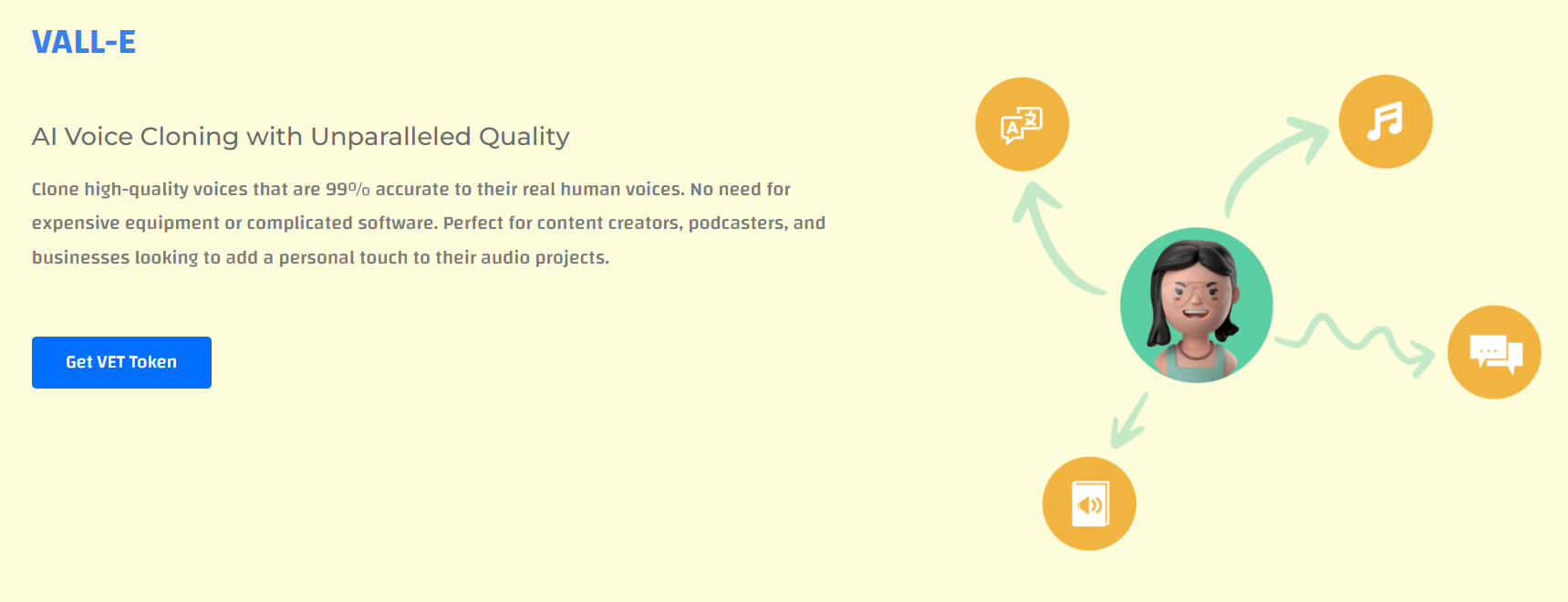Published on: July 4, 2023 Updated on: February 13, 2024
VALL-E Review 2024: What it is, Features, and Best Use Cases
Author: Lianne Jones

If you’ve been following the world of AI in recent years, you’ll have witnessed a huge growth in the number of AI art tools. Whether it be an AI art generator or an AI video creation tool, the artistic possibilities using AI are endless. However, this is just the start, as Microsoft has shown with the recent release of VALL-E.
Similar to DALL-E but designed for voices instead, this is a powerful AI tool that has the potential to change everything. After just three seconds of listening, VALL-E can replicate any voice, making it incredibly easy for us to do voiceovers. If you’ve never used VALL-E before and you want to learn more, you’ve come to the right place.
In today’s post, we’re going to review VALL-E. We’ll tell you everything you need to know about the platform before you use it. Let’s begin!
What is VALL-E?
The best place to start is with a description of what VALL-E is. To put it simply, VALL-E is an AI tool that offers text-to-speech functionality. Developed by Microsoft, this tool can convert the audio we input and convert it into anyone’s voice, which Microsoft calls a neural codec language model. The tool is not yet released for general use, but people are already talking about what this tool potentially has to offer.
We can use VALL-E to convert text into audio using just a three-second audio sample. If that doesn’t sound impressive, we don’t know what will.
VALL-E review

Now we’ve given you a quick explanation of what it is, it’s time for us to get stuck into the main bulk of this post, which is, of course, our VALL-E review. We’re going to cover everything you need to know about this AI tool. The key things we’ll look at are as follows:
- What can VALL-E do?
- How does VALL-E work?
- Why should we use VALL-E?
- The main features
- Ease of use
- Overall quality
- Pricing
What can VALL-E do?
The main thing VALL-E can do is take our speech and use it as a sample to produce output. Microsoft and the other developers working on VALL-E claim that the tool is already trained with roughly 60,000 hours of English audio content. As a result, VALL-E can provide users with accurate output for the given text input.
Using VALL-E, users will be able to input the text they want to produce an audio file for, upload a three-second audio sample, and use VALL-E to convert the text and audio file into speech. In other words, VALL-E takes a voice and replicates it to produce a neat voiceover in just seconds. Unfortunately, because this tool hasn’t been released yet, we can’t confirm or deny if it has these capabilities or not.
How does VALL-E work?

Like other text-to-speech AI tools such as Fake You, VALL-E offers impressive audio generation capabilities, but how does it work? Well, VALL-E is trained on a huge dataset, which allows it to produce accurate results. Text-to-speech technology uses artificial intelligence to translate the information we’ve input into voice, audio, and speech.
Because this tech has been trained on more than 60,000 hours of audio from over 7,000 speakers, it also can recreate accents. Thanks to AI-driven algorithms, this AI model can do all of this with simple text inputs and just three seconds of audio. If you use VALL-E, you can use the tool to mimic unseen speakers’ voices, including your own. Incredibly, this tool can even mimic your emotions.
Why should we use VALL-E?
If you’ve never used a text-to-speech tool before, you might now be wondering why you would need to use one. Well, while we don’t all have use for tools like VALL-E, there are plenty of reasons why others might. Some people might even use tools like VALL-E to make money using AI.
For example, content creators might use VALL-E to speed up their content creation process. This can help them put more content out there, which in turn can increase their engagement. We’ve listed some of the main reasons you might want to use it below!
- To create voiceovers quickly.
- To create presentations.
- To create a better customer service experience.
- To produce content quicker.
- To mimic the voices of real people.
The main features

It can be hard to review an AI neural codec language model tool that the general public doesn’t have access to yet. Having said that, we can find a lot of information concerning VALL-E features on the VALL-E and Microsoft websites. There are currently two different VALL-E models to choose from. These are:
- VALL-E
- VALL-E X
Both models have a variety of different features for us to make the most of. At the moment, the most important features you need to be aware of are:
- Text-to-speech converter
- Audio clip editor
- Voice mimicking
- Emotion detection
These are the most important and valuable features VALL-E has to offer. It is these features that make it possible for users to generate audio and turn text into high-quality voiceover files. Of course, the text-to-speech feature is the most important. This feature takes our text input and turns it into audio based on the audio samples we upload while maintaining speaker identity .
After that, the audio clip editor tool comes in handy because it lets us alter the audio. The voice-mimicking tool is a neat tool for recreating voices, and it can be used to mimic the voices of celebrities with an uncanny speaker similarity. Finally, the emotion detection tool is valuable because it can detect the emotional tone in our voice and recreate it, resulting in speech naturalness, which is what most of us want.
Ease of use
Unfortunately, we can’t report on how easy this AI model is to use because we don’t yet have access to the tool. However, going off what we know already and the developers behind the tool, we can assume it will be relatively easy to use. The fact we only have to input text and upload three seconds of audio tells us this platform will make it incredibly easy for us to generate audio.
However, until VALL-E is released, we won’t know how easy the user interface is to navigate and how each tool will be laid out. For now, we’ll just have to wait and see.
Overall quality

When it comes to the overall quality of VALL-E, this is something else we will have to wait for. Once again, though, we can make some good assumptions based on the evidence we’ve already been shown. Some audio examples have been released that show what VALL-E can do.
Those examples sound pretty great, which shows us that this AI tool might have the potential to become one of the best text-to-speech apps on the market. However, we must also say that some audio examples weren’t that great. They still sound good, but they do almost sound a little bit robotic too. It will be interesting to see the overall quality of the platform when it’s released to the general public.
Pricing
At the time of writing this review, there isn’t any information out there regarding the pricing for VALL-E. This is mainly because it isn’t available for public use yet. Therefore, Microsoft hasn’t released any information concerning the pricing structure yet. For all we know, itmight be free to use, or there could be a monthly subscription fee we have to sign up for. We’ll just have to wait to find out.
VALL-E AI use cases
Let’s finish off with some AI use cases. We have three AI use cases to show you. Those are:
- Customer support
- Content creation
- Robotic systems
1. Customer support
Businesses can integrate the audio created using VALL-E into their customer support systems. VALL-E can also be used to create a virtual assistant that provides voice-over customer service.
2. Content creation
Content creators, whether that be vloggers, YouTubers, or influencers can use this AI-based tool to add audio to their content. They can also use this AI tool to produce podcasts using written text.
3. Robotic systems
An interesting use for VALL-E is in robotic systems. VALL-E can be integrated into robotic systems to streamline various processes and interact with humans.

Final thoughts
That concludes our review. In this review, we’ve told you everything you need to know about VALL-E. We’ve told you what it is, what it can do, why you should use it, what the main features have to offer, and more. We’ll have more information for you about this neural codec language model tool when it’s released, but until then, we’ll just have to be patient.
Frequently asked questions
When will VALL-E be available?
Unfortunately, we don’t yet know the answer to that question. Microsoft announced VALL-E in January 2023, but they didn’t say when it will be released.
Can VALL-E understand other languages?
At the moment, Microsoft’s VALL-E is trained in over 60,000 hours of English language. In the future, we can probably expect the tool to be trained in other languages, too.
Lianne Jones
TopApps writer
Recent Articles

In 2024, your smartphone camera is about to get a whole lot smarter. AI camera apps are transforming the way we capture and...
Read More
Learn how to use advanced search tools, newsletters, and reviews to uncover the perfect AI-focused podcast for you.
Read More
AI chatbot vs virtual assistant? who reigns supreme? We're dissecting the differences, strengths, and weaknesses, using data-driven insights.
Read More